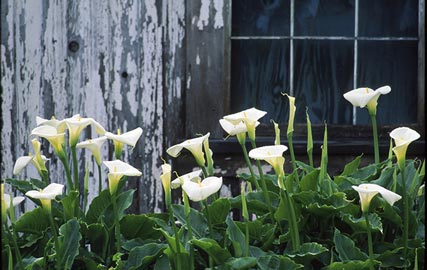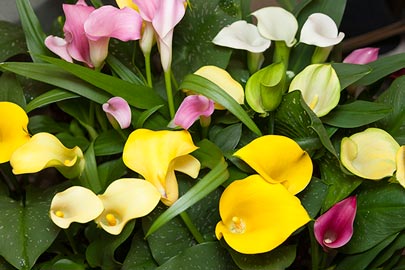
The calla lily isn’t picky. It’s one of those few plants that’ll work inside or out. In their native southern Africa, callas are evergreen perennials found along stream banks and moist areas. In warm-weather (Zone 8-10) parts of the southern and western United States, they’ll also grow as perennials, usually with a dormant spell in winter.
In the North, take your pick. Callas will grow as houseplants all year, as summer annuals in outdoor pots, or in the ground in summer, although they’ll have to be dug and stored dormant inside to keep them another year.
Wherever they grow, callas send up stalks that produce upward-facing, trumpet-shaped flowers of white (the prevailing color), orange, yellow, purple, pink and green. The white-speckled leaves add another interesting dimension.
Planting callas
Inside, plant dormant calla rhizomes (the fat underground stems from which the shoots and roots emerge) 3 to 4 inches deep in moistened potting mix. Keep the soil damp, place the pot next to a south- or west-facing window, and in 10 to 12 weeks, flowers should open. Blooms can last for months.

In Zones 8 and warmer, plant rhizomes outside in spring about 4 inches deep, preferably in a damp location with a bit of afternoon shade. Let the leaves yellow and die back over winter, but don’t dig the plants since they’re dormant, not dead.
In colder areas, dig, dry and clean outdoor-grown calla rhizomes after fall’s first frost, and store them inside in peat moss or sand, as with gladioli or dahlias. Callas growing in summer pots also can be saved this way, or they can be left dry in pots all winter in storage – so long as temperatures don’t dip below 20 degrees.
3 more things about callas…
1.) Callas aren’t really lilies. Their flowers just look like them.
2.) Callas hate it dry. Keep the soil around them damp, just as in their native habitat.
3.) Don’t eat them. All parts are high in calcium oxalate, which can cause swollen lips and throats and digestive upset if eaten.